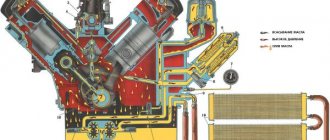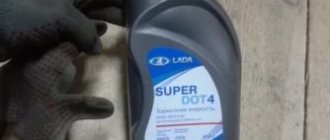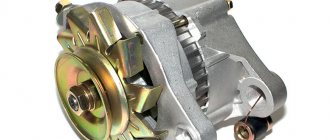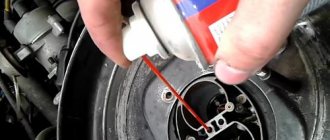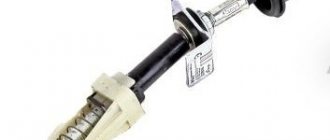Bleeding the clutch of the VAZ 2107, like other cars of the classic family (starting from 2101), is necessary after any operation to repair parts of its drive. It is necessary to bleed the circuit after replacing the master or working cylinder, hose or tube, as well as when changing the fluid. The task of the manipulation is to ensure that there is no air in the clutch hydraulic drive.
How to perform this procedure on a carburetor or injection car and what difficulties there may be - see the instructions.
In what situations should you pump
Any repair of the hydraulic drive that causes its depressurization, as well as changing the working fluid, is a direct indication for pumping. But, even if the parts or fluid have not been changed, the clutch is bled when air enters, disrupting the operation of the hydraulic drive.
Signs that the circuit is airy and the clutch needs bleeding on a VAZ 2107 are:
- pedal travel is too soft;
- difficulties and crunching when shifting gears, up to the impossibility of shifting and/or moving;
- howling or vibration when holding the clutch pedal in gear.
One of the ways to diagnose incomplete disengagement of the Zhiguli clutch is to hang the rear axle (on a lift or jacks), start the engine, engage 3rd or 4th gear and hold the clutch depressed. If the wheels begin to rotate quickly even with the pedal depressed, it means that the engine is not completely disconnected from the transmission. To correct the situation, you need to either adjust the drive or bleed the VAZ 2107 clutch cylinder.
Step by step instructions
- Pour brake fluid into the prepared container.
- The process is performed using a bleeder fitting located on the cylinder body. The protective cap must be removed and the rubber tube must be put on.
- Place the lower tip of the tube into a container with TJ. Make sure that it does not exceed the liquid level in the container.
- Pour hydraulic fluid into the expansion tank.
- Loosen the fitting and unscrew it half a turn.
- On command, the assistant needs to press the clutch pedal (interval - 2-3 seconds), holding it in the pressed position.
- Liquid and air will begin to flow out of the tube through the hose.
- Repeat until no more air comes out.
- The assistant presses the clutch pedal, in the meantime you need to tighten the fitting by putting the cap on it.
During the process, it is important to look at the level of brake fluid in the reservoir, and if there is a deficiency, add a little. The liquid indicator at the end of pumping is located at the bottom mark of the filler neck.
Thus, having familiarized yourself with the information presented, it will not be difficult for you to carry out this procedure yourself.
How to bleed the clutch on a VAZ 2107: preparation
Clutch slave cylinder and its bleeder fitting
Before bleeding the clutch on a VAZ 2107, you need to prepare tools and consumables:
- wrench 8;
- dry rags;
- a thin transparent hose (a medical dropper works well);
- container for draining the working fluid;
- liter bottle of fresh brake fluid.
As a key that will be used to open the bleeder fitting, it is better to take a socket, clamping, or deep socket 8, since open-end wrenches lick the edges. The length of the hose should be about 0.5-1 meter. Brake fluid of the VAZ 2107 can be used as a working fluid, grade DOT-4 (more often used on injection cars) or DOT-3 (usually filled in older carburetor models). A container of 0.5 liters is enough, even if a complete replacement is needed, so taking more makes sense only when it is also necessary to bleed the brake system.
What is needed to bleed the clutch on a VAZ
Unfortunately, you will not be able to complete the entire procedure yourself. You will need the help of at least one person to push the right pedals for you in time, nothing else is required from him.
If there is air in your hydraulic drive, then, as a rule, it has already entered the brake fluid. First you need to replace it and then bleed the clutch.
You will need a small set of tools:
- Empty containers for draining.
- New brake fluid.
- Waste cleaning cloth.
- Rubber hose.
- A wrench, for most models you will need a figure eight wrench.
Plus your assistant - and you have assembled the main set of tools for bleeding the clutch on a VAZ.
How to bleed the clutch on a VAZ 2107: injector and carburetor
All Zhiguli cars use the same type of hydraulic clutch, so the type of power supply to the VAZ 2107 engine (injector or carburetor) and its model (2101, 2103, 2104, 2105, 2106) do not play a decisive role. The only nuances can be in the features of access to the drive cylinder, since the carburetor allows you to bleed the clutch on a VAZ 2107 a little faster than an injector. Below we will look at detailed instructions on what methods you can pump up and why you may not succeed.
On cars with an injection power system, a larger air filter and a fuel adsorber are used, located on the left side of the engine compartment. They leave less space to access the cylinder from above (no pit), but usually do not require removal for bleeding.
Bleeding the hydraulic clutch of a VAZ 2106
If the question arises of how to bleed the clutch of a VAZ 2106, you should prepare the necessary plumbing tools and auxiliary material in the form of a container with brake fluid, an auxiliary hose and a reservoir for filling the drained waste.
If the hydraulic clutch of a VAZ 2106 is pumped after replacing the brake fluid, then it is first necessary to clean the drain fitting of the main clutch cylinder (clutch master cylinder) from dirt and dust deposits. This work is carried out using a special brush with a working surface made of steel wire.
To gain solid knowledge of how to bleed the clutch, you need to follow the following algorithms:
- We put the pre-stored rubber hose onto the fitting outlet, which has been treated and cleaned of dirt and dust deposits. This connecting element must be pulled onto the fitting with some force. We direct the other outlet of the hose to the tank to receive used brake fluid.
- To carry out the operation of bleeding the clutch, the help of another person is required, who will help carry out subsequent actions while inside the vehicle.
- The assistant must depress the pedal of the device 5-6 times, and the time interval between pumping should be 3-4 seconds. If, after pressing the pedal device, the product does not restore its original position, then it should be returned to the starting position.
- After recessing, the clutch pedal is held in the recessed position by an assistant in the cabin. At the same time, a car enthusiast working on a hydraulic drive must slightly unscrew the fitting to drain the working fluid using a wrench. At this time, the “brake fluid” with air bubbles begins to come out.
- After the leak from the rubber hose has stopped, tighten the drain fitting and give the command to your partner in the cabin to release the pedal so that it assumes a free position.
- We repeat the previous technological cycle with unscrewing and tightening the fitting element. A logical continuation of these actions should be a gradual “hardening” of the clutch pedal, i.e. it should acquire elasticity.
- The frequency of these successive operations must be repeated 3 to 5 times or until the end of the release of air bubbles from the rubber hose directed into the reservoir for draining the used brake fluid. In this case, it is important to control the volume of brake fluid in the standard clutch reservoir. The brake fluid level must not be allowed to decrease less than 10 mm from the lower edge of the hydraulic drive reservoir!
- After creating a vacuum in the clutch hydraulic drive, it is necessary to tighten the fitting device completely and remove the hose from the rubber base. The other end of the hose must be kept in a tank with a “brake seal”, because it contains used liquid, after which it is necessary to drain this liquid.
- Add working fluid to the standard tank to the specified amount and tighten the tank cap with a little force.
- We wipe off excess leaked fluid with a dry rag and test the clutch hydraulic drive unit for possible leaks. Next, we try the operation of the hydraulic drive with the engine turned on and then switching on the speeds. During normal operation the vehicle can be driven.
An important addition: while the hydraulic clutch of the VAZ 2106 is being pumped, one should not forget about adding brake fluid to the standard reservoir in order to prevent air masses from entering the hydraulics.
How to properly bleed the clutch on a VAZ 2107: step-by-step instructions
Bleeding the clutch on a VAZ 2107 should be done in a pit, overpass or lift, but in this case it may be necessary to dismantle the sub-engine protection (if installed). It is also possible to bleed from above by simply placing the machine on a level surface, but this is a little more difficult. The easiest way to pump the clutch of a VAZ 2107 is with an assistant, in which case the order of work will be as follows:
Video instructions on how to bleed the clutch on a classic VAZ in several ways
- Open the hood and remove the cover from the clutch expansion tank, located on the left on the engine shield, you need to add fluid there to the maximum.
- You need to get to the clutch slave cylinder, located to the left of the gearbox bell.
- Remove the rubber cap from the bleeder fitting, put a 8mm wrench on it and put on the hose.
- Pour 100 grams of fresh DOT 3/4 fluid into a container for draining and dip the end of the hose into it (to prevent air leaks).
- Ask an assistant to pump the clutch pedal about 5 times at intervals of 1-3 seconds and leave it depressed.
- Open the fitting of the clutch slave cylinder 0.5-1 turn of the key so that liquid flows through the hose.
- Close the fitting when the liquid stops flowing.
- Check the fuel fluid level in the tank, and if it drops, add more.
- Repeat steps 5-8 until the liquid begins to flow in an even stream without bubbles.
- Tighten the fitting, wipe the parts with a rag to remove any leaks and put the rubber cap back on.
- Check the fluid level in the tank (if it’s low, add it again) and screw on the cap.
By following these simple procedures, you will bleed the clutch drive system on a classic and achieve smooth operation.
Setting up the VAZ clutch
To make the adjustment, you will need two keys, and you will not have to spend a lot of time on all operations. The pedal travel for VAZ cars should be from 120 to 130 millimeters. The stroke is adjusted by turning the adjusting nut. The distance from the pusher rod to the end of the release fork should be within 5 mm. Before making adjustments, remove the spring from the bracket and fork. To increase the stroke, the fasteners need to be tightened; to decrease, on the contrary, they need to be unscrewed. The control bolt is tightened with the second wrench. After achieving the desired parameters, you need to press the pedal 3 times and measure the distance, repeat the procedure if necessary.
Fluid replacement
It is also recommended to replace the working fluid before bleeding. Remove the cap and place a pre-prepared hose on the fitting, the other end of which must be lowered into the drain container. Using a size 8 wrench, turn the fitting 3/4 of a full turn. Now you can remove the liquid. Pressing the pedal several times, repeat these actions until all the working fluid has flowed out, then tighten the fitting. If the clutch pedal does not rise on its own, pull it up by hand. Fill the hydraulic system with new brake fluid through the clutch reservoir.
Changing the brake fluid can be done gradually. To do this, liquid must be added to the tank in small doses in the intervals between pressing the pedal. When clean liquid flows from the working cylinder (WC), tighten the fitting and fill the barrel to a level no lower than 1.5-2 cm from the top edge. This is a fairly effective method, since the old medium, due to impurities and contaminants, settles and leaves the system first.
- DOT-4 in a volume of 1.0 – 1.5 liters, with a reserve in the tank;
- plastic container to change waste;
- rubber hose;
- key to “10”;
- rags;
- flashlight;
- new boots on the working cylinders as needed.
- Install the machine above the inspection hole;
- Open the hood, unscrew the cap from the expansion tank of the master brake cylinder;
- Bleed the brake pedal, hold it in the lower position (assistant function);
- Remove the rubber cap on the working cylinder, put the hose on the grease fitting, and lower the end into a plastic container;
- Using the key “10”, unscrew the grease fitting, drain the fuel fluid, tighten the valve;
- Repeat the procedure with pumping until light DOT-4 liquid flows from the hose.
3 flushes are enough to completely update the system. After each cycle, replenish the missing amount of DOT - 4 in the expansion tank. After updating the contour of one working cylinder, we move on to the next. DIY replacement completed.
We pump the front and rear brake circuits according to an identical scheme; there are no fundamental differences.
How to pump the clutch of a VAZ 2107 yourself: alternative methods
If asking someone to pump the pedal is not possible, you need to bleed the VAZ 2107 clutch without an assistant. There is nothing complicated in this procedure either. You can bleed the clutch on a VAZ 2107 yourself in the following ways:
How to bleed the clutch on a classic yourself
- pedal fixation;
- pressure;
- vacuum;
- by gravity.
Bleeding the VAZ 2107 clutch with pedal fixation
Since it is impossible to bleed the clutch pedal of a VAZ 2107 and at the same time work with the fitting yourself, you can try using a gas lift of a suitable length with a force of 100 N instead of an assistant. A board, a piece of pipe or another oblong object that can be used to support the pedal in the depressed position will also do. The further procedure for bleeding the Zhiguli clutch is the same as with an assistant. The only difference is that you will have to pump the pedal and fix it when depressed yourself.
Bleeding the VAZ 2107 clutch under pressure
The second option on how to bleed the clutch of a VAZ 2107 yourself is under pressure. To do this, you need to take a large syringe (preferably 20 cubic meters or more), some kind of container for collecting liquid and perform the following manipulations:
- Draw up a full syringe of TJ.
- Connect the syringe and the fitting with a hose from the dropper.
- Open the hydraulic clutch expansion tank.
- Open the bleeder fitting with a size 8 key and start pumping liquid into the cylinder with a syringe, creating pressure.
- Press fresh fluid into the cylinder until there are no more bubbles in the reservoir.
- Tighten the fitting, wipe everything with a rag, put on the cap and close the tank.
To prevent the tank from flowing over the edge when pumping, you need to either pump out excess liquid in a timely manner (for example, with a second syringe), or provide a container into which they will pour themselves.
Bleeding the VAZ 2107 clutch with vacuum
You can create a vacuum in the system and bleed the clutch slave cylinder using a large medical syringe.
Another way to quickly pump the clutch on a VAZ 2107 alone is to pump it with vacuum (vacuum). It occurs on the same principle as under pressure, but the liquid does not need to be supplied, but rather pumped out. The general procedure for bleeding the clutch cylinders on the seven is as follows:
- Open the reservoir and add liquid up to the neck.
- We put the key on the fitting, put the hose on it, and the other end on the syringe.
- We open the fitting and use a syringe to draw liquid from the cylinder, controlling the level in the tank.
- Periodically add DOT-4, not allowing it to fall below 1.5-2 cm from the bottom of the tank.
- We stop drawing the liquid after it flows into the syringe in a stream without bubbles, and tighten the fitting.
- We remove the device, wipe the cylinder of liquid, put on the cap and close the reservoir lid.
Bleeding the clutch on a VAZ classic by gravity
You can bleed the clutch on a VAZ 2107 with your own hands by gravity, but it will take a little longer. To do this you need:
- Open the tank cap.
- Place the hose onto the fitting, dipping the end into the drain container, and open the fitting.
- Start adding liquid to the tank, watching the stream flow down the hose.
- Stop adding when the stream becomes smooth and free of bubbles.
- Tighten the fitting, remove the hose, wipe away any leaks, put on the cap and close the tank cap.
What is needed to bleed the clutch of a VAZ 2107-2101
The procedure for bleeding the clutch on a VAZ 2101 in accordance with manuals for car repair and maintenance requires the presence of an assistant who will be directly in the car during repair work. However, this work can be done alone, although it will take more time. Also, in addition to having certain repair skills, the owner will need a certain set of tools:
- A simple rubber tube for bleeding air and waste fluid.
- A set of keys for dismantling the master cylinder tank and other clutch parts in case of malfunctions.
- New fluid to fill the clutch tank. As usual, ordinary brake fluid of the DOT-3 or DOT-4 standard is most often used as such a substance.
In the case of self-repair and bleeding of the VAZ 2105 clutch, the owner will have to alternately carry out work both in the engine compartment and inside the car.
This procedure is necessary in several cases:
- Planned replacement. The liquid used cannot always have the same properties. Over time, it wears out, creating less pressure in the cylinder. This affects the performance of the car. To avoid such a problem, you need to change the fluid regularly.
- Poor quality of materials used. Everyone has bought a poor quality product at least once. In this case, this will affect not only the operation of the car, but also the serviceability of other parts. That is why you need to change the low quality fluid to something better.
- Clutch depressurization. As soon as some elements of the system begin to fit loosely, liquid leakage and air ingress are possible. Both are equally bad. The fluid runs out quickly and the clutch does not work well.
- Repair work. If the clutch system fails, you need to take the car to a service center or repair it yourself. In any case, the parts will lose their tightness, air will get into them, and liquid will leak out. Why this is poorly described in the previous paragraph.
Please note! In the event of a fluid leak, bleeding the clutch will only help temporarily. In order to repair clutches, you need to check the entire system for holes or cracks. The time of air entry depends only on the hole. The main thing to remember is that over time it will become larger, which means air will get in faster.
You can understand that air has entered the hydraulic system by three main signs:
- Initial stage. The pedal is easy to press, gear shifting works, but not very well.
- Middle stage. The gears are no longer switched, the pedal is easily squeezed.
- Last stage. The pedal does not return to its place and becomes stuck.
First, let's bleed the clutch on the VAZ-2106.
For ease of work, it is better to drive the car into a pit or overpass. Additionally, outside assistance will be required.
Before starting work, you need to clean the reservoir from dust, check the fluid level and add it if necessary.
The clutch bleeder located on the slave cylinder should be cleaned. Then the protective cap is removed from this fitting and the tube is put on it. The other end must be lowered into the drain container.
Before starting pumping, it is advisable to immediately check the possibility of unscrewing the fitting; often it becomes very sour in its seat, and it is quite difficult to tear it out of place.
If you manage to tear the fitting out of place, you need to tighten it back. After this, the assistant inflates the system by sharply pressing the pedal 4-5 times, after which he holds it.
The fitting is unscrewed half a turn, after which liquid with air bubbles will flow down the tube. As soon as the fluid stops flowing, the fitting must be tightened.
Afterwards, you need to repeat the process of pumping and draining the liquid several times, periodically checking the level in the tank.
It is important to ensure that liquid begins to flow through the tube without bubbles, after which the fitting is finally tightened and the cap is put on it.
On the VAZ-2107, the preparatory work is identical - the system is checked for leaks, the tank and fitting are cleaned.
It may be necessary to remove the dust shield to access the working cylinder fitting (on injection VAZ-2107 models).
Next, the tube is put on the fitting; first it must be “torn” out of place.
The bleeding process on this car is carried out as follows: the fitting is unscrewed half a turn, the assistant sharply presses the pedal, and then gradually releases it, while the fitting does not need to be tightened back.
The assistant must press the pedal sharply until liquid without air begins to flow through the tube, after which the pedal must be pressed and held, and the fitting must be tightened.
Regarding the pumping itself, it should be noted that the process itself should not be long: on a VAZ-2106 - 4-5 pumps followed by draining and 5-7 sharp presses on the pedal with a leisurely release - on a VAZ-2107.
If the process takes more steps, you need to look for where air got into the system, fix the problem, and then pump it again.
You can check the operation of the drive after bleeding while driving.
Start the car, move slowly and change gears. If there are no signs of hydraulic drive malfunction, we can assume that the pumping was done correctly.

